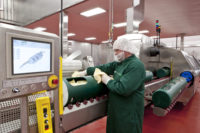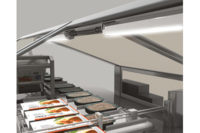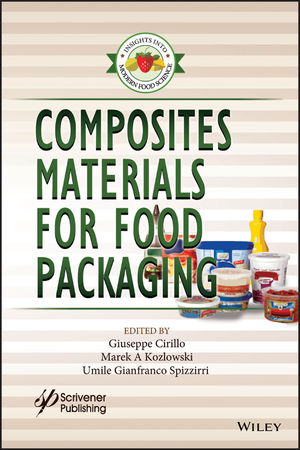Packaging That Sells

The stand-up pouch packaging industry grew at an 11.6% rate per year from 2006-2011, to become a $2.3 billion market, according to a study conducted by Allied Development Corp.

Farmland Foods’ Oven Perfect products save on prep time.

To better “speak” to its international consumers, Marvell Foods printed bi-lingual (Spanish) labels on the packaging of its Lovella Cuisine line.

For Pinnacle Foods, it’s all about prominently displaying the aspects of the product on the front of the packaging.




Whether it’s through clear messaging, front-of-pack labeling or using eco-friendly materials, sometimes packaging is what sells the product.
That’s why today’s packaging initiatives must be on target, meaning they must “speak” to consumers.
Refrigerated & Frozen Foods interviewed several frozen food manufacturers. Take a look at the Top 11 best new frozen packaging concepts.
1. Glare-free, matte-finish. Cincinnati-based AdvancePierre Foods’ brands division re-launched its Fast Fixin’ Pretzel Crusted Chicken Tenders in a glare-free, matte-finish bag with eco-friendly water-based ink printed on the front. The bag offers clear messaging and easy visibility.
2. Stand-up options. ConAgra Foods Lamb Weston, Kennewick, Wash., introduced new bags for its Alexia line of all-natural frozen products. These new bags “stand up in retailers’ freezers, making them easier for retailers to store and consumers to find,” says Robert Owen, marketing director.
3. Display sourcing information. For Pinnacle Foods Group, LLC, it’s all about prominently displaying the aspects of the product. That’s why for its Mrs. Paul’s and Van de Kamp’s ParchmentBake, the Parsippany, N.J., company put important product features on the front of the packaging. “We include the low-calorie and low-fat count on the front of packaging, our easy-prep, no-mess ParchmentBake seal and the Global Aquaculture Alliance seal,” says Lisa Barrette, senior marketing director of seafood.
4. QR codes. More and more quick-response (QR) codes are being placed on packages to invite users to learn more about a product, receive coupons or take part in surveys or company-sponsored donations. In honor of Earth Day, for example, Cedarlane Natural Foods, Carson, Calif., placed QR codes on its new CedarLEAN line to invite consumers to participate in its “Plant-a-Tree” program. Consumers scanned the QR code on the side of the box and made a $2 donation toward planting a tree. In return, Cedarlane Foods offered a $1-off coupon, good for any Cedarlane Foods’ items.
5. Going bi-lingual. To better “speak” to its international consumers, Marvell Foods, Boca Raton, Fla., printed bi-lingual (Spanish) labels on the packaging of its new Lovella Cuisine line. Doing so will “thereby increase, or potentially increase, our consumer base and appeal to the ‘extreme value’ or ‘value-conscious consumer’ who does not want to compromise taste, quality or nutrition, despite a lower and more economic price point,” says Marilyn Raybin, president.
6. Improving functionality. A product is no good if consumers face difficulty just opening the package. Hormel Foods introduced a new pouch design for its Hormel brand pepperoni products. “The pouch design is very functional, allowing the consumer a convenient way to use and store the product,” says Steven Venenga, vice president, marketing, meat products for the Austin, Minn., company. The pouch design includes a tear notch to avert the usage of scissors and a gusseted base that allows the pouch to stand on its own. Plus, the re-sealable feature prevents leakage.
7. Snap-on lids. Dairy Enterprises Inc.’s new containers for its SMITH’S premium ice cream feature a snap-on lid, easy-to-read graphics and a contoured carton design for easier scooping. “The improved design is in response to what our consumers requested,” says Penny Baker, director of marketing. “Now, we’ve made it easier for them to find, scoop and keep their favorite ice cream as fresh as can be.”
8. Keeping food fresh longer. The DuPont Awards for Packaging Innovation named Curwood Inc., a Bemis division, the diamond winner for excellence in innovation, cost/waste reduction and sustainability for its FreshCase packaging for fresh red meats. The Oshkosh, Wis.-based supplier created the vacuum package to maintain red meat’s color through a found-in-nature proprietary additive in the contact layer of the barrier package. FreshCase packaging also is said to extend shelf life 10 times longer than store-wrapped meat.
9. Environmentally friendly trays. H.J. Heinz also received a DuPont award for its environmentally friendly trays for its Weight Watchers Smart Ones. Traditional CPET microwaveable trays were replaced with a hybrid material combining polypropylene with calcium carbonate, thus reducing greenhouse gas emissions by more than 45% during production, compared with CPET.
10. Ultra-freshness preservation freezing system. Also honored for its excellence in innovation are Japanese companies Mutsumi Chemical Industry Co., SUN Electric Co. and Enshu-Kasei Co. for their high “electric potential” and electro-conductive packaging. This ultra-freshness preservation freezing system uses technology to ensure food quality and increase both shelf life and appeal.
11. Cook in the bag. Farmland Foods introduced Oven Perfect Fresh Pork, a new line of fresh pork products that are marinated, dry-rub seasoned and ready to cook right in the bag. “We have conducted extensive consumer research to understand the different types of pork consumers, what motivates them and what needs are most important,” says Brendan Smith, vice president of marketing for the Kansas City, Mo., company. “A common theme across several consumer groups was an ongoing pursuit of a fresh, high-quality, homemade meal solution without the time and hassle of starting from scratch.”
STANDING THE TEST OF TIME
The stand-up pouch packaging industry grew at an 11.6% rate per year from 2006-2011 to become a $2.3 billion market. And thanks to an assortment of packaging projects, it could reach $4 billion by 2016, according to “Stand-up Pouches 2012-2016,” a new study conducted by Allied Development Corp., Burnsville, Minn.
This study also reveals that frozen fruits, vegetables and entrees surpassed liquid food applications as the largest market segment for global packaging sales of stand-up pouches, accounting for 37% of global sales.
Key drivers of the study include the fact that stand-up pouches deliver significant cost savings and favorable environmental metrics when compared to rigid containers, the accelerating per-capita consumption of stand-up pouches in global regions other than the traditional markets of Europe, North America and Japan, and the continued proliferation of new applications for stand-up pouches, such as zippers and spouts.
Looking for a reprint of this article?
From high-res PDFs to custom plaques, order your copy today!













